SOLUTION 3: a.) Here are a carefully labeled sketch of the region, a rough sketch of the resulting Solid of Revolution, and a circular cross-section at $x$. In this example, the cross section is called an annulus, a circular region of radius $R$ with a smaller concentric circular region of radius $r$ removed. It is IMPORTANT to mark ALL of $x$, $r$, and $R$ in the sketch of the region !!!
 $ \ \ \ $
$ \ \ \ $
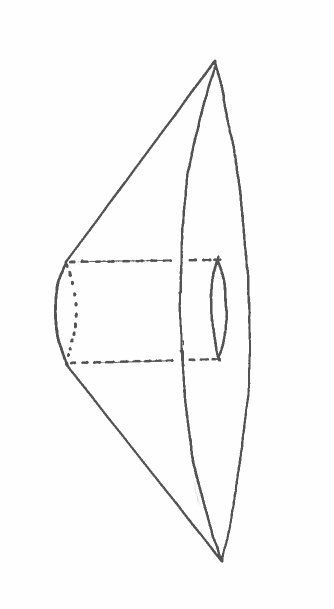 $ \ \ \ $
$ \ \ \ $

The area of the circular cross-section is
$$ A(x)= \pi R^2 -\pi r^2 = \pi (e^x)^2 - \pi (1)^2 $$
Thus the total volume of this Solid of Revolution is
$$ Volume = \int_{0}^{\ln 3} \Big( \pi (e^x)^2 - \pi (1)^2 \Big) \ dx $$
SOLUTION 3: b.) IMPORTANT CHANGE: Because we are revolving the region about the $y$-axis, we must make slices perpendicular to the $y$-axis at $y$ !!! This ensures that the slices are CIRCULAR. Here are a carefully labeled sketch of the region, a rough sketch of the resulting Solid of Revolution, and a circular cross-section at $y$. In this example, the cross section is called an annulus, a circular region of radius $R$ with a smaller concentric circular region of radius $r$ removed. It is IMPORTANT to mark ALL of $y$, $r$, and $R$ in the sketch of the region !!!
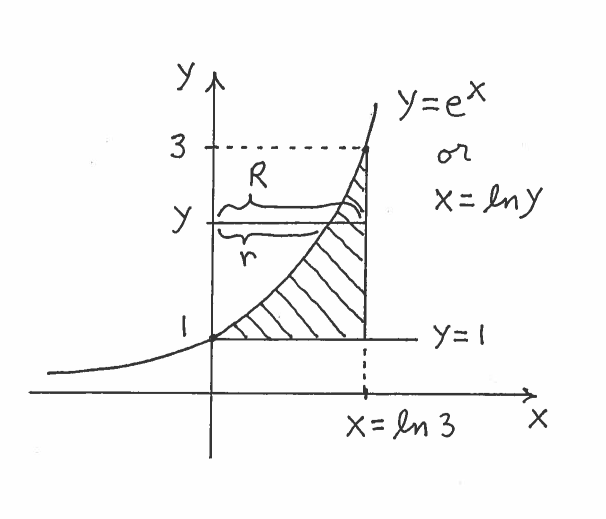 $ \ \ \ $
$ \ \ \ $
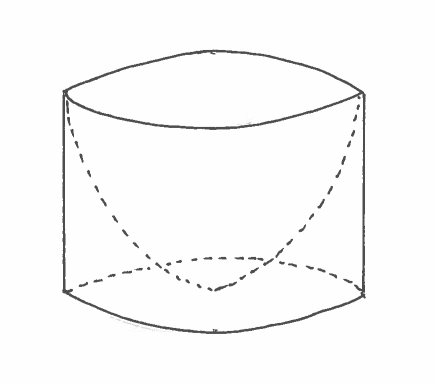 $ \ \ \ $
$ \ \ \ $

The area of the circular cross-section is
$$ A(y)= \pi R^2 -\pi r^2 = \pi (\ln 3)^2 - \pi (\ln y)^2 $$
Thus the total volume of this Solid of Revolution is
$$ Volume = \int_{1}^{3} \Big( \pi (\ln 3)^2 - \pi (\ln y)^2 \Big) \ dy $$
SOLUTION 3: c.) IMPORTANT CHANGE: Because we are revolving the region about the $y$-axis, we must make slices perpendicular to the $y$-axis at $y$ !!! This ensures that the slices are CIRCULAR. Here are a carefully labeled sketch of the region, a rough sketch of the resulting Solid of Revolution, and a circular cross-section at $y$. In this example, the cross section is called an annulus, a circular region of radius $R$ with a smaller concentric circular region of radius $r$ removed. It is IMPORTANT to mark ALL of $y$, $r$, and $R$ in the sketch of the region !!!
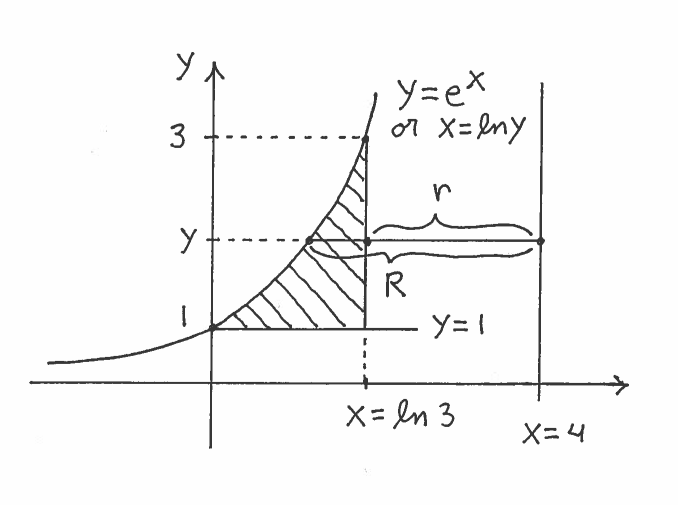 $ \ \ \ $
$ \ \ \ $
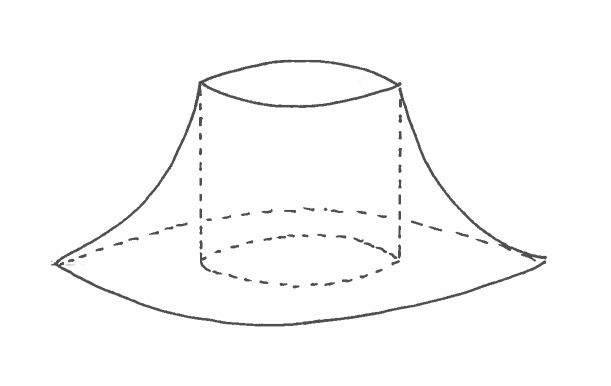 $ \ \ \ $
$ \ \ \ $

The area of the circular cross-section is
$$ A(y)= \pi R^2 -\pi r^2 = \pi (4- \ln y)^2 - \pi (4- \ln 3)^2 $$
Thus the total volume of this Solid of Revolution is
$$ Volume = \int_{1}^{3} \Big( \pi (4- \ln y)^2 - \pi (4- \ln 3)^2 \Big) \ dy $$
SOLUTION 3: d.) Here are a carefully labeled sketch of the region, a rough sketch of the resulting Solid of Revolution, and a circular cross-section at $x$. It is IMPORTANT to mark BOTH of $x$ and $r$ in the sketch of the region !!!
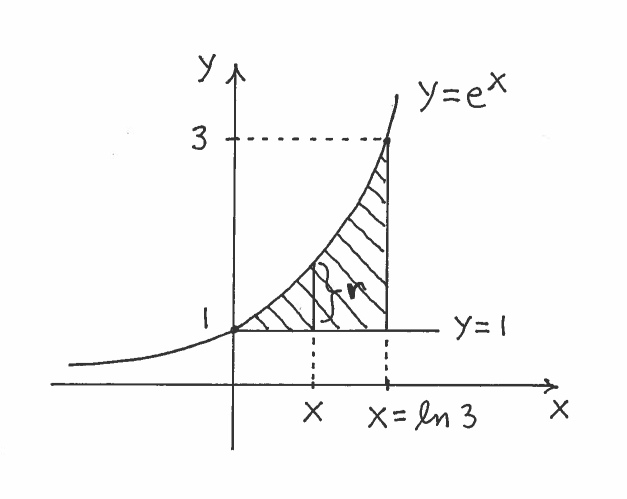 $ \ \ \ $
$ \ \ \ $
 $ \ \ \ $
$ \ \ \ $

The area of the circular cross-section is
$$ A(x)= \pi r^2 = \pi (e^x-1)^2 $$
Thus the total volume of this Solid of Revolution is
$$ Volume = \int_{0}^{\ln 3} \pi (e^x-1)^2 \ dx $$
SOLUTION 3: e.) IMPORTANT CHANGE: Because we are revolving the region about the $y$-axis, we must make slices perpendicular to the $y$-axis at $y$ !!! This ensures that the slices are CIRCULAR. Here are a carefully labeled sketch of the region, a rough sketch of the resulting Solid of Revolution, and a circular cross-section at $y$. In this example, the cross section is called an annulus, a circular region of radius $R$ with a smaller concentric circular region of radius $r$ removed. It is IMPORTANT to mark ALL of $y$, $r$, and $R$ in the sketch of the region !!!
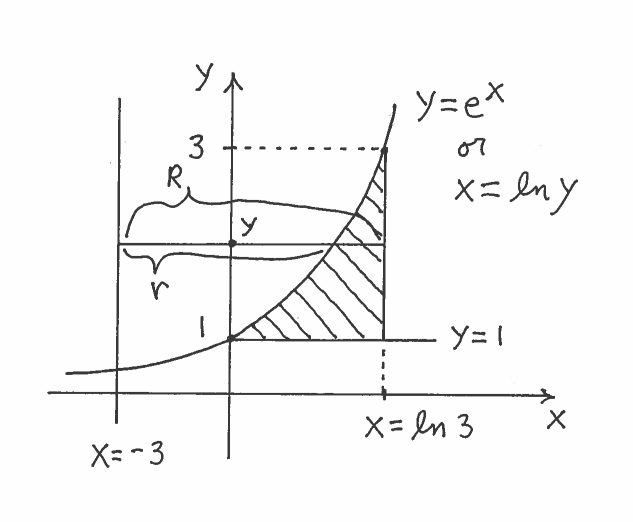 $ \ \ \ $
$ \ \ \ $
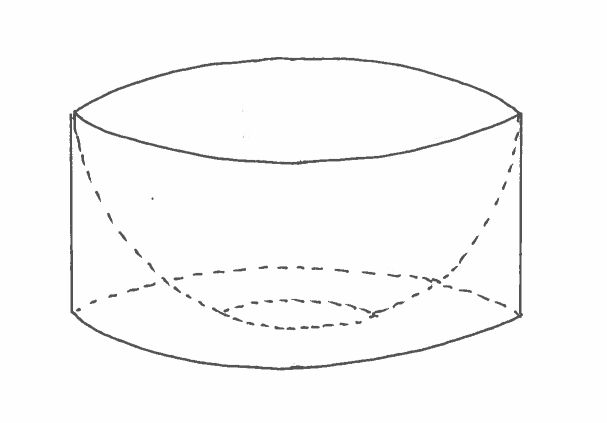 $ \ \ \ $
$ \ \ \ $

The area of the circular cross-section is
$$ A(y)= \pi R^2 -\pi r^2 = \pi (\ln 3 - (-3))^2 - \pi (\ln y - (-3))^2 = \pi (\ln 3 + 3)^2 - \pi (\ln y + 3)^2 $$
Thus the total volume of this Solid of Revolution is
$$ Volume = \int_{1}^{3} \Big( \pi (\ln 3 + 3)^2 - \pi (\ln y + 3)^2 \Big) \ dy $$
SOLUTION 3: f.) Here are a carefully labeled sketch of the region, a rough sketch of the resulting Solid of Revolution, and a circular cross-section at $x$. In this example, the cross section is called an annulus, a circular region of radius $R$ with a smaller concentric circular region of radius $r$ removed. It is IMPORTANT to mark ALL of $x$, $r$, and $R$ in the sketch of the region !!!
 $ \ \ \ $
$ \ \ \ $
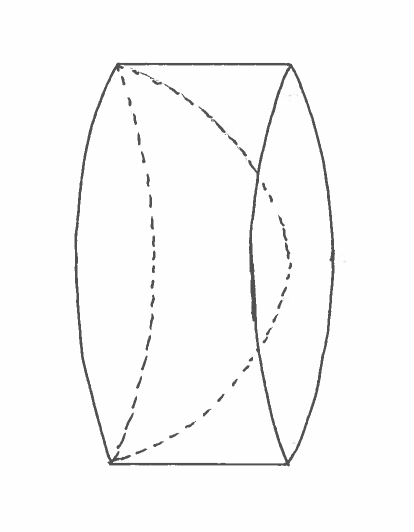 $ \ \ \ $
$ \ \ \ $

The area of the circular cross-section is
$$ A(x)= \pi R^2 -\pi r^2 = \pi (2)^2 - \pi (3-e^x)^2 $$
Thus the total volume of this Solid of Revolution is
$$ Volume = \int_{0}^{\ln 3} \Big( \pi (2)^2 - \pi (3-e^x)^2 \Big) \ dx $$
Click HERE to return to the list of problems.
 $ \ \ \ $
$ \ \ \ $
 $ \ \ \ $
$ \ \ \ $

 $ \ \ \ $
$ \ \ \ $
 $ \ \ \ $
$ \ \ \ $

 $ \ \ \ $
$ \ \ \ $
 $ \ \ \ $
$ \ \ \ $

 $ \ \ \ $
$ \ \ \ $
 $ \ \ \ $
$ \ \ \ $

 $ \ \ \ $
$ \ \ \ $
 $ \ \ \ $
$ \ \ \ $

 $ \ \ \ $
$ \ \ \ $
 $ \ \ \ $
$ \ \ \ $

 $ \ \ \ $
$ \ \ \ $
 $ \ \ \ $
$ \ \ \ $
